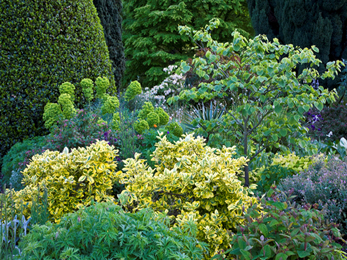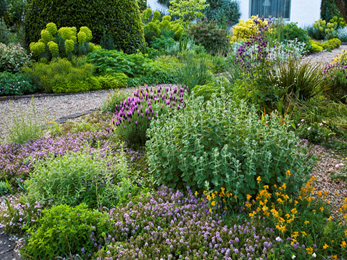Beth Chatto
Frances Lincoln 2000

Cold, dry and windswept, with the dreaded north-easterlies blowing straight from Siberia, Essex could hardly be said to offer a Mediterranean climate, yet many Mediterranean plants thrive in Mrs Chatto’s garden, protected as they are by carefully planted hedges and windbreaks.
This jewel of a book tells of the creation, against considerable climatic difficulties, of one of the most interesting ‘new ideas’ – gardening on gravel. In Essex, where rainfall is minimal, probably the lowest in England, and summers are growing warmer, Mrs Chatto set out to make a garden which demands little or no watering. She takes us step by step through its creation from a derelict car park with a subsoil of yellow sand and gravel, to a flowering cornucopia overflowing with exciting and unusual plants and, in turn, gives us an invaluable lesson on how meticulous preparations pay off. No shirking here – at least two spits of spade dug by hand.
First of all, in order to determine the shape and size of her beds, she took ordinary garden hoses, placed them strategically to mark the perimeters of her beds and, with a tug here or a tug there, changed the outlines to arrive at the desired effect before starting the really hard work.
And what work! She used a digger which penetrated 60 centimetres into the soil to allow in air and rainwater. Then it was ploughed and rolled and covered with a thick layer of compost from mushrooms and wood ash to a depth, again, of two spits*. Mrs Chatto mentions that two spits deep might seem excessive but reminds us that it was “more like gardening on the beach” and she wanted all her plants to have a good start. This advice should be of help for Mediterranean gardeners who often have to work on inhospitable ground and no one can deny that this is the secret of the successful rearing of plants. No wonder all her gravel garden plants look comfortable and happy in their environment with all that lovely nourishment at their toes.
After the preparation, the planting began and her detailed explanations of how this was carried out are enthralling and of immense value to beginners and advanced gardeners alike. In the second year a half inch mulch of gravel was spread on all the beds and straw placed at the back of the borders to keep them cool in dry summers.
The book continues by taking us through the seasons, starting with early spring with hellebores, euphorbias and beautiful early bulbs such as fritillaries, tulips, anemones and bergenias, all of which can easily be grown in Mediterranean regions. Then the spears of alliums emerge and turn into great round heads, giving height and perspective to the spring garden.
Summer offers more delights with achilleas, phlomis, verbascums, cistus, lavenders and a host of others. The photographs in this section are particularly alluring – yellow beds, hot colours and more alliums stretching their round, fluffy heads above brilliantly coloured shrubs. Grasses are used in abundance to take over as summer colours begin to fade, adding dimension to the beds. Of course, it is not simply the choice of plants, it is the way in which Mrs Chatto groups them. She has a unique eye for ‘good neighbours’ both in height and colour, and it is this wonderful choice which delights the eye and makes a visit to her garden such an exciting event.
The chapter on late summer deals with silver and grey plants, so important in our Mediterranean gardens. It was decided that sedums and bulbs that might have been swamped by their larger bedfellows in the gravel garden would be planted in a new scree garden. A site was chosen on the south side of the house, with a Judas tree as a central feature. Mrs Chatto admits endearingly that, like most of us, ideas do not come racing to her but take time and thought and the bare earth was a rather daunting prospect. But the same technique was used – a hosepipe draped on the soil, tugged and flipped, and there was the whole design under her eyes, five lovely island beds and all was in place. However, things were not as simple as they had seemed and levels had to be changed in order to give a more fluid, natural shape. The island beds were made and raised slightly with local paving but it was not until Mrs Chatto was sure that the beds did not resemble ‘dogs’ graves’ that she started planting with choice alpines and other accommodating plants.
This review gives only an outline of this delightful book, but I cannot encourage you too strongly to try and visit the exceptional nursery and garden yourselves. If you are lucky enough, as I was, to meet Mrs Chatto who gave me many moments of her valuable time, your journey will be doubly enriched. You will also be tempted to carry away some rare and interesting plants from the nursery, many of them relishing our kind of climate and soil.
One final word about the lavish photographs which make this book all the more tempting. They are taken by Steven Wooster, a garden photographer and graphic designer who has worked in Mrs Chatto’s gardens over many years.
Review by Joanna Millar – Mediterranean Gardening France
* a spit is the depth of earth cut by a spade
Editor’s note:
These photographs of the gravel and scree gardens (also by Stephen Wooster) are taken from the Beth Chatto Gardens website and used with the kind permission of Julia Boulton, Mrs Chatto’s granddaughter.
The gravel garden through the seasons
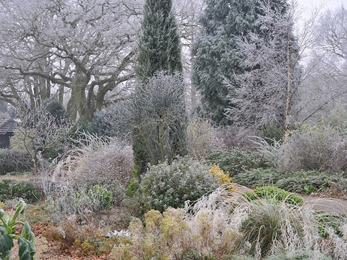
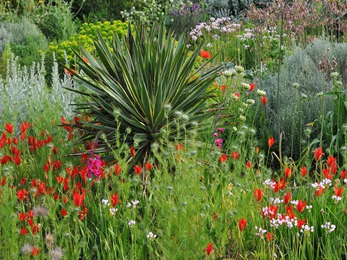
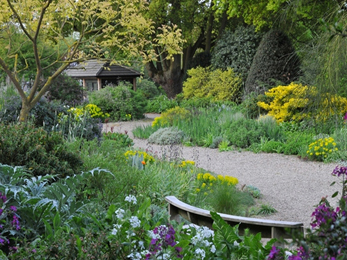
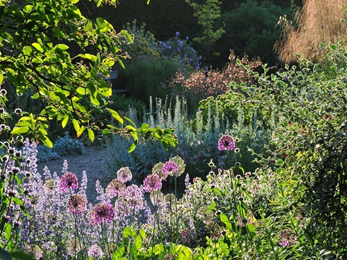

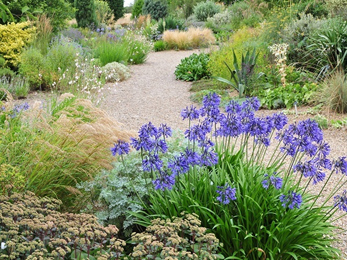
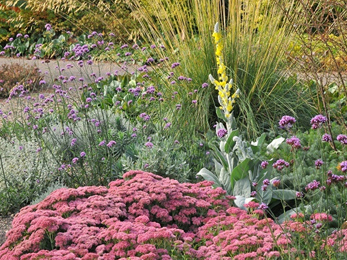
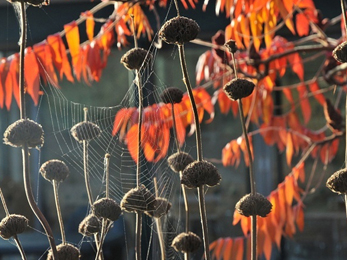
The scree garden

